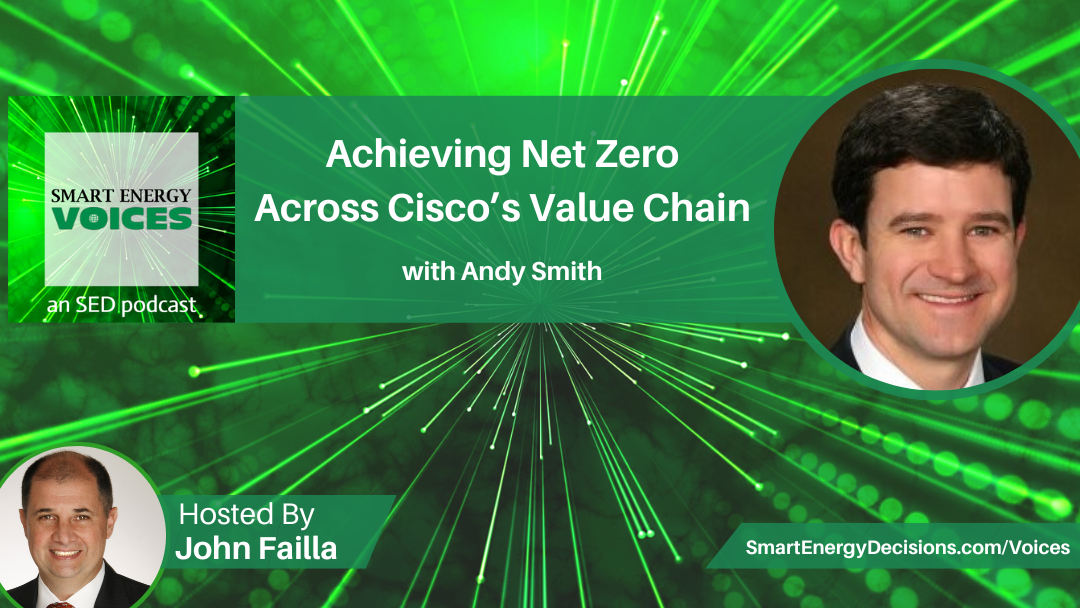Smart Energy Voices- Episode 75
Achieving Net Zero Across Cisco’s Value Chain
Listen on your Preferred Podcast Player »
In this episode of Smart Energy Voices, host John Failla shares a special keynote presentation from the inaugural Net Zero Forum featuring Andy Smith, Senior Manager of Global Energy Management and Sustainability at Cisco Systems. In his presentation, Andy provides a deep dive into the process Cisco recently went through to evaluate, establish and certify its net-zero goal through the Science Based Targets initiative (SBTi).
You will want to hear this episode if you are interested in...
- Powering an inclusive future for all [02:22]
- Science Based Target initiative (SBTi) [04:50]
- Third-party verification of goals [07:05]
- Cisco’s Scope 3 challenges [10:58]
- Real estate transformation [13:56]
- Carbon offset strategy [16:14]
Creating new goals
Cisco has a long history of setting ambitious climate and sustainability goals. Over the last couple of years, the organization realized it needed to catch up with some market trends. While the company had an aggressive, absolute greenhouse gas reduction goal and an 85% renewable electricity target, the other leaders in sustainability were setting RE100 and net-zero goals.
With prior goals wrapping up, Cisco went through a year-long process to engage in the next phase of goal setting. Ultimately, the organization set a net-zero goal that covers all of its Scope 1, 2, and 3 emissions to be achieved by 2040. Cisco also has aggressive near-term targets including a 90% reduction of Scope 1 and 2 emissions by 2025 and a 30% reduction focused on its largest categories of Scope 3 emissions by 2030.
Cisco chose to align with the SBTi Net-Zero Standard to have third-party verification of its aggressive goals. Before the company began the process in January 2021, internal stakeholders, employees, and customers were pushing for an updated goal that would include net zero. At the time, Cisco wasn’t ready to set that net-zero standard. While it was reporting on a couple of categories of Scope 3, the company needed to take a step back to further understand its emissions.
Scope 3 challenges
At 99% of its portfolio, Scope 3 is by far Cisco’s largest source of emissions. The use of sold goods and products is about 75% of those emissions and the company’s greatest challenge. Cisco sells many products and gear that plug into its customers’ electric grids, releasing a lot of emissions in the end. The following 20% of Scope 3 emissions is from the company’s supply chain contracts and indirect procurement. The company will focus on those two categories over the next fifteen years.
Although Scope 1 and 2 are only 1% of Cisco’s emissions, the company has engaged in a robust strategy to achieve its Scope 1 and 2 goals. Addressing these emissions also helps Cisco’s customers and suppliers meet their goals. If they can replicate some of the things Cisco is doing, that will also help Cisco achieve its Scope 3 goal.
Renewable electricity is a large part of Cisco’s strategy. Clean, zero-emission power will move the company about 75% of the way towards its reduction goal for Scope 1 and 2. Cisco is focusing its efforts on renewable energy. The company has generated a few megawatts of on-site solar and hopes to triple that over the next three years.
Cisco’s hybrid transformation
Cisco is going through a real estate transformation. This hybrid transformation began before COVID but was accelerated after. Currently, the company has 80 million square feet of building space, but the occupancy levels of those spaces are low. Employees want to work wherever and whenever they want. Engineers love to work at home and aren’t coming into the office as much as they had. In response, Cisco is modifying workspaces into collaboration centers where teams can work together. As Cisco transforms the workplace, it will see energy savings by reducing its square footage.
Some energy savings of a hybrid workplace will increase home energy usage. While that’s a challenge the whole industry will need to address, companies can keep in mind that commute emissions are also being reduced. Cisco believes the hybrid transformation is a positive for the world from a climate perspective.
Connect with Andy Smith
Andy has over 15 years of experience in the field of sustainability and currently leads Cisco’s Global Energy Management and Sustainability team. He started working at Cisco in 2009 and has helped develop Cisco’s sustainability program into what it is today by leading a number of initiatives, including developing and achieving multiple sustainability goals, managing global energy efficiency programs, deploying a global energy and sustainability information system, and creating Cisco’s annual greenhouse gas inventories and Corporate Social Responsibility reports. Through these efforts, Cisco has been recognized consistently over the years as a leader in sustainability by numerous organizations, including Barron’s, EPA, Association of Energy Engineers, Newsweek, CDP, Dow Jones Sustainability Index, and Sustainability Roundtable.
Prior to joining Cisco, Andy worked as a consultant at Rocky Mountain Institute and DOMANI Sustainability Consulting in Colorado and served as Energy Manager for Washtenaw County Government in Michigan.
Andy has a B.S. in Mechanical Engineering from Washington University in St. Louis, a B.A. from Oberlin College, and an MBA from the University of Colorado. He is also a Certified Energy Manager and Certified Carbon Reduction Manager from the Association of Energy Engineers. Andy and his family live in Boulder, Colorado and enjoy just about all outdoor activities, including rock climbing, hiking, biking, and skiing. They are also musicians and love to travel.
- Smart Energy Decisions
-
Follow us on LinkedIn
Subscribe to Smart Energy Voices on
Apple Podcasts, Google Podcasts, Android, Spotify, Stitcher, TuneIn Radio, aCast, PlayerFM, iHeart RadioIf you're interested in participating in the next Smart Energy Decision Event, visit smartenergydecisions.com or email our Community Development team at [email protected]












